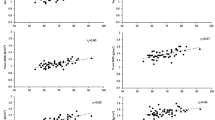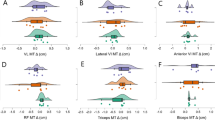Abstract.
The purpose of this study was to determine the distribution and architectural characteristics of skeletal muscle in elite powerlifters, and to investigate their relationship to fat-free mat (FFM) accumulation and powerlifting performance. Twenty elite male powerlifters (including four world and three US national champions) volunteered for this study. FFM, skeletal muscle distribution (muscle thickness at 13 anatomical sites), and isolated muscle thickness and fascicle pennation angle (PAN) of the triceps long-head (TL), vastus lateralis, and gastrocnemius medialis (MG) muscles were measured with B-mode ultrasound. Fascicle length (FAL) was calculated. Best lifting performance in the bench press (BP), squat lift (SQT), and dead lift (DL) was recorded from competition performance. Significant correlations (P≤0.01) were observed between muscle distribution (individual muscle thickness from 13 sites) and performance of the SQT (r=0.79 to r=0.91), BP (r=0.63 to r=0.85) and DL (r=0.70 to r=0.90). Subscapular muscle thickness was the single best predictor of powerlifting performance in each lift. Performance of the SQT, BP, and DL was strongly correlated with FFM and FFM relative to standing height (r=0.86 to 0.95, P≤0.001). FAL of the triceps long head and vastus lateralis were significantly correlated with FFM (r=0.59, P≤0.01; 0.63, P≤0.01, respectively) and performance of the SQT (r=0.45; r=0.50, respectively; P≤0.05), BP (r=0.52; r=0.56, respectively; P≤0.05), and DL (r=0.56; r=0.54, respectively; P≤0.01). A significant positive correlation was observed between isolated muscle thickness and PAN for triceps long-head (r=0.64, P≤0.01) and gastrocnemius medialis (r=0.48, P≤0.05) muscles, but not for vastus lateralis (r=0.35). PAN was negatively correlated with powerlifting performance. Our results indicate that powerlifting performance is a function of FFM and, therefore, may be limited by the ability to accumulate FFM. Additionally, muscle architecture appears to play an important role in powerlifting performance in that greater fascicle lengths are associated with greater FFM accumulation and powerlifting performance.
Similar content being viewed by others
Author information
Authors and Affiliations
Additional information
Electronic Publication
Rights and permissions
About this article
Cite this article
Brechue, W.F., Abe, T. The role of FFM accumulation and skeletal muscle architecture in powerlifting performance. Eur J Appl Physiol 86, 327–336 (2002). https://doi.org/10.1007/s00421-001-0543-7
Accepted:
Published:
Issue Date:
DOI: https://doi.org/10.1007/s00421-001-0543-7




